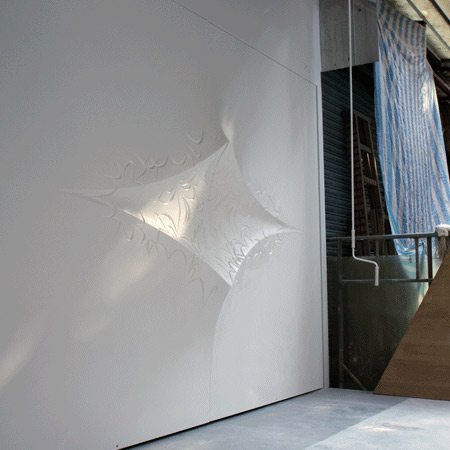
Yud Yud by Davidclovers and C.E.B. Reas
Hong Kong studio Davidclovers and Los Angeles artist C.E.B. Reas have created a studio facade in Hong Kong where LED lighting pulses through patterns cut in the surface of two large Corian doors.
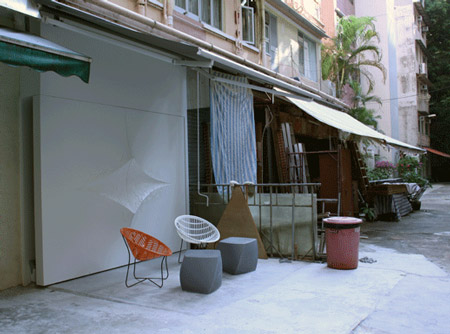
Called Yud Yud, the project is an addition to Davidclovers' own studio.
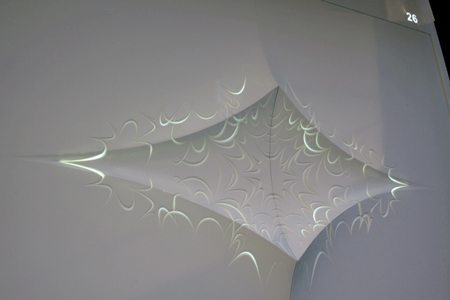
The doors are puckered in the middle by a diamond-shaped relief and squiggles are milled out of the surface, illuminated from behind by pulsing LEDs.
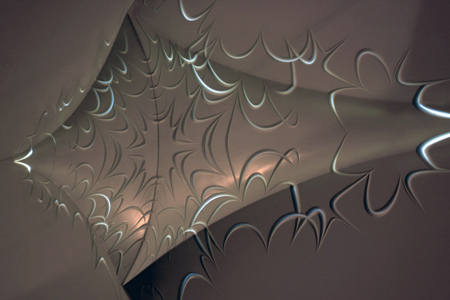
Watch a movie about the project here.
Here's some more information from Davidclovers:
Yud Yud
by davidclovers and C.E.B. Reas
Yud Yud is the product of an evolving collaboration between davidclovers, artist C.E.B. Reas and DuPont China. It is the first application of back lit Corian™ exterior in China. Set within an old, medium density walking area of Wan Chai, Yud Yud stands in contrast to its surroundings. It builds upon the persona of the typical Hong Kong gate, pushing it toward the enigmatic. Designed from the interior to extend the pinup space of the davidclovers studio it is designed to be explored, touched and engage other forms of sight. Onlookers have been found rubbing it. It is an urban artifact not meant to be fully understood but capture and interact with one’s imagination.
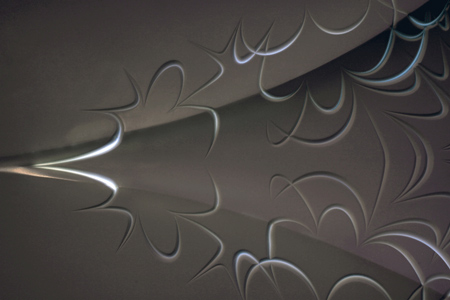
Much of the visual and spatial ambiguity of the storefront lie in the tension designed between dimensions. For instance, two and three dimensions are blurred by both forming and etching an otherwise matte, Corian™ facade. The design engages the fourth dimension using animated LED lighting that produces a “twilight” affect. What appears heavy and dense at moments reverberates between opaque, translucent and transparent; slowly pulsing etched lines appear and then fade out and disappear.
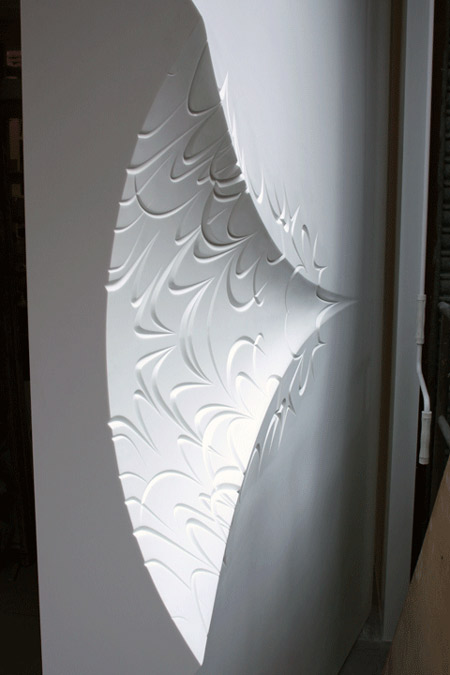
The storefront has both operable and fixed components. Each apply DuPont Corian Solid Surface™ to a wall sandwich composed of a welded steel frame, inset animated LED light system, sheathed in the front with treated plywood and in the rear with aluminum panels. The form of the storefront is simultaneously guided by the basic physics of door swings and a capillary-like plasticity. Mostly flat, the storefront uses 15cm to produce a very subtle pucker-like formation that spans across the doors. Each leaf is symmetrical and comprised of three facing pieces of Corian Solid Surface™ that are seamlessly joined together using a liquid form of the same material.
The unique application of Corian™ lies not only in its exterior use and translucency but the combination of techniques overlaid and oscillating across one another; each adroitly executed by SpeedTop Hong Kong. At one scale – the scale of the door – sheets are thermoformed, a pressure reflected in the subtlety of the design. At a smaller scale – that of the ornamental texture – CNC tool paths swim through the substrate to produce calligraphy-like formations. Each scale was designed three dimensionally and rides the limits of both the material and their processes.
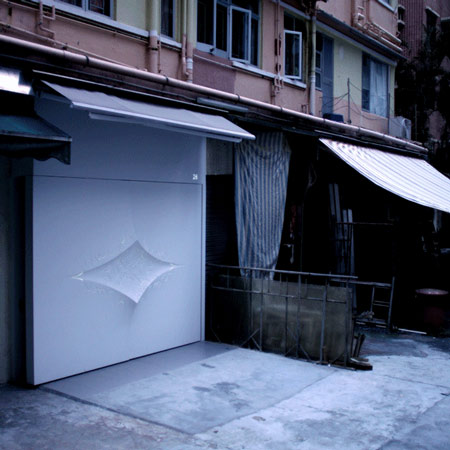
Similar innovation is explored at the level of software programming. Reas’ algorithmic, 2D Processing line work was a launching point for the collaboration with davidclovers. These dense, animated, line, networks (typically shown in prints or on screen) evolve endlessly. They are software process as art. Reas developed a custom software application for this project and Lunar House with knobs that allow sampling, sorting and the adjustment of line work.
Making these processes material is the intersection between Reas artwork and davidclovers’ architecture. Line quantities are reduced and edited, but they are anything but stabilized. Each line is reactivated in multiple ways. First, by forming tool paths three dimensionally shadow lines vibrate and translucency varies. Cut into flat sheets of Corian™ prior to forming, each line is designed to capture artificial light and shadow; to snap in and out of focus. The overall “tooling” (using large 1.5 meter x 2 meter wood molds) and forming was calibrated in relation to the CNC milled texture. Rather than encapsulating the texture between seams, it moves across them, bending and cornering. This requires an intricate three dimensional choreography of the CNC texture with each corresponding, formed, Corian™, sheet. Once they are aligned, this detail allows the texture to at once flatten the overall form (moving across edges), as much as augment it (deepening, drifting and fading in and out within it).
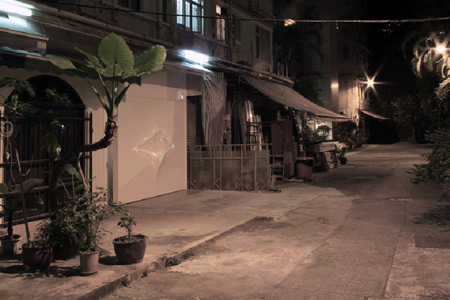
Finally, the wall section cavity and depth is regulated with each of these parameters. Where the texture is the furthest from the lighting it is the deepest and most intense, where it is the closest it fades out. This adds a delicate, effulgent quality to the slowly dimming and brightening LED’s as their light courses through each three dimensional line – appearing as if the texture itself is phosphorescent. It is this tight integration, spanning across media and use of constraints that ultimately produces the enigmatic somewhat preternatural character Yud Yud, awaiting interaction in this overlooked morsel of a neighborhood in Hong Kong.
Design:
davidclovers and C.E.B. Reas
Design Team:
David Erdman, Clover Lee and Casey Reas, Fei Mui, Jason Dembski
CLIENT: DuPont China/davidclovers
LOCATION: Wan Chai, Hong Kong
TYPE: Commercial Storefront
STATUS: Completed